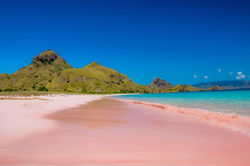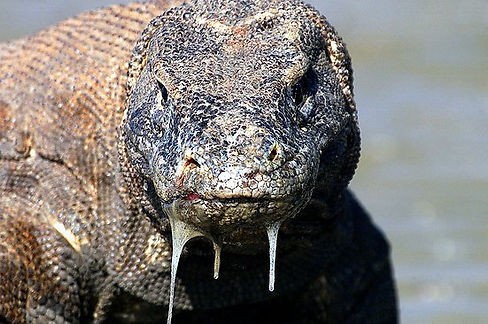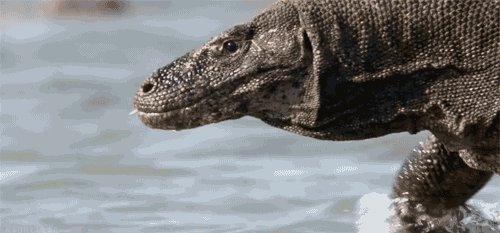
ABOUT
V. Komodoensis
Komodo Dragons are the largest living reptile on earth. Also known as "land crocodiles", these land dwelling lizards are known for their savagery and size. They hunt bulls, boars and deer on the little southern islands of Indonesia with both their ferocious teeth and venom glands. Scroll down to learn more about Komodo Dragons and their beautiful habitat.

EVOLUTION
V. Komodoensis
50,000 Years Ago
The Megalania was a giant land-roaming lizard that lived in southern Australia in the Pleistocene era that became extinct around 50,000 years ago. They were around 15 ft long and weighed an estimated 730 lbs.
Present Day
Size and weight are the two main factors that has changed since the Megalania inhabited Australia. The present day Komodo Dragon is around 5 ft shorter and 500 lbs lighter. Though they are a smaller model of the prehistoric land lizard, the Komodo Dragon and the Megalania share a lot of similar traits including diet and looks.
MEGALANIA
V. KOMODOENSIS


AUSTRALIA TO ASIA
The Collision
About 15 million years ago, Australia and Southeast Asia collided, which allowed for animals, including the prehistoric version of the Komodo Dragon, to migrate from their homeland to a new location. They relocated to a string of islands near Timor in present day Indonesia. The Komodo is an ancestor of the Megalania which inhabited southern Australia.


For the Last 900,000 Years
For the last 900,000 years, scientists believe that Komodo Dragons have lived in the archipelago in between Java and Timor. Fossils have been found on Komodo Island and Flores island for centuries and new findings are confirming that Komodo Dragons immigrated from Australia.
INDONESIA




The beautiful islands of Komodo, Rinca, Flores, Gili Motang and Padar form a sort of archipelago in between two major islands Java and Timor (purple islands). Ever since immigrating from Australia, Komodo Dragons have lived freely on these islands usually near beaches or uninhabited land. These islands are now a National Park and is conserved to protect the various wildlife that lives there.

Komodo Island
Rinca Island
Flores Island
 Komodo Island Pink Beach |  Rinca Islands |  Padar Islands |  Komodo Island |
|---|---|---|---|
 Komodo Island National Park |  Komodo Island |  Komodo Island National Park |  Flores Island |
 Flores Island Crater Lake |

BEHAVIOR
V. Komodoensis
DIET
Komodo dragons are carnivores. They can hunt prey twice their size including water buffalo, deer, carrion, boars, pigs and humans. Komodo Dragons are known for their savagery and bloodlust. Komodo Dragons can also eat 80% of their own body weight in one feeding.


SIZE
The average wild Komodo Dragon is 8.5 ft long and weighs around 200 lbs, while captive dragons weigh more. The largest Komodo ever recorded was 10.3 ft long and weighted 366 lbs. The tail of the Komodo dragon is usually the same size as its body. The Komodo has 60 serrated teeth measuring 1 inch each to eat its large prey.
VENOM
It is widely disputed in the scientific community on whether or not Komodo Dragons are venomous. Their saliva is deadly, but they also have venom glands in their jaw which store deadly toxins. It is argued that these glands contain no biological significance and that their existence is only evolutionary.
SALIVA

The saliva of the Komodo dragon stores around 50 deadly strains of bacteria specifically E. coli, Staphylococcus, Providencia, Proteus morgani, and P. mirabilis. When the Komodo Dragon bites, the toxins in its saliva take around 24 hours to infect the bloodstream and kill its victim. Somehow, their saliva does not affect them and they have become immune to it.

CARNIVORES
The Komodo kills its prey by springing up and knocking it over with their huge claws. Then they use their sharp, serrated teeth to bite at their prey until their prey dies. If the prey escapes, it will die within 24 hours of blood poisoning because the Komodo's saliva contains deadly strains of bacteria that do not effect it.



DAILY LIFE
V. Komodoensis
TONGUE
The Komodo has a long forked tongue used to smell much like a snake does. It samples the air and the tongue retreats back into the mouth so chemical analyzers can detect whether or not prey is nearby.



MATING
Mating is between May and August, and eggs are laid in September. About 20 eggs are deposited in abandoned megapode nests which are self-dug incubation holes.The eggs are incubated for seven to eight months, hatching in around April. Baby Komodo Dragons are small and therefore dwell in trees, safe from predators and cannibalistic adults, until they are mature.

PARTHENOGENESIS
Definition: parthenogenesis is a type of asexual reproduction in which the offspring develops from unfertilized eggs.
Komodo Dragons mate, but it is not uncommon for a female Komodo to go through Parthenogenesis, so they can reproduce with an unfertilized egg. It is a quite rare asexual phenomenon that does not require both egg and sperm. It does not happen to every female Komodo, but has been seen in the wild and captivity.
V. Komodoensis
 |  |  |  |
|---|---|---|---|
 |